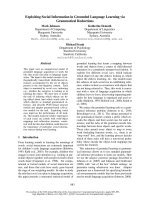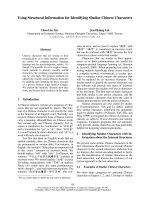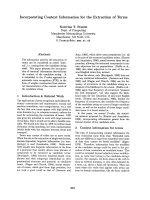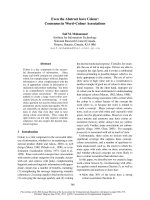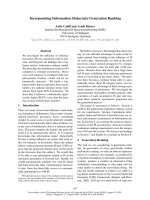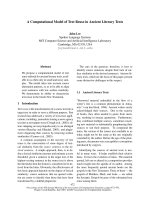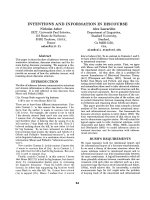Báo cáo khoa học: "Incorporating Extra-linguistic Information into Reference Resolution in Collaborative Task Dialogue" pot
Bạn đang xem bản rút gọn của tài liệu. Xem và tải ngay bản đầy đủ của tài liệu tại đây (459.94 KB, 9 trang )
Proceedings of the 48th Annual Meeting of the Association for Computational Linguistics, pages 1259–1267,
Uppsala, Sweden, 11-16 July 2010.
c
2010 Association for Computational Linguistics
Incorporating Extra-linguistic Information into Reference Resolution in
Collaborative Task Dialogue
Ryu Iida Shumpei Kobayashi Takenobu Tokunaga
Tokyo Institute of Technology
2-12-1,
ˆ
Ookayama, Meguro, Tokyo 152-8552, Japan
{ryu-i,skobayashi,take}@cl.cs.titech.ac.jp
Abstract
This paper proposes an approach to ref-
erence resolution in situated dialogues
by exploiting extra-linguistic information.
Recently, investigations of referential be-
haviours involved in situations in the real
world have received increasing attention
by researchers (Di Eugenio et al., 2000;
Byron, 2005; van Deemter, 2007; Spanger
et al., 2009). In order to create an accurate
reference resolution model, we need to
handle extra-linguistic information as well
as textual information examined by exist-
ing approaches (Soon et al., 2001; Ng and
Cardie, 2002, etc.). In this paper, we incor-
porate extra-linguistic information into an
existing corpus-based reference resolution
model, and investigate its effects on refer-
ence resolution problems within a corpus
of Japanese dialogues. The results demon-
strate that our proposed model achieves an
accuracy of 79.0% for this task.
1 Introduction
The task of identifying reference relations includ-
ing anaphora and coreferences within texts has re-
ceived a great deal of attention in natural language
processing, from both theoretical and empirical
perspectives. Recently, research trends for refer-
ence resolution have drastically shifted from hand-
crafted rule-based approaches to corpus-based ap-
proaches, due predominately to the growing suc-
cess of machine learning algorithms (such as Sup-
port Vector Machines (Vapnik, 1998)); many re-
searchers have examined ways for introducing var-
ious linguistic clues into machine learning-based
models (Ge et al., 1998; Soon et al., 2001; Ng
and Cardie, 2002; Yang et al., 2003; Iida et al.,
2005; Yang et al., 2005; Yang et al., 2008; Poon
and Domingos, 2008, etc.). Research has contin-
ued to progress each year, focusing on tackling the
problem as it is represented in the annotated data
sets provided by the Message Understanding Con-
ference (MUC)
1
and the Automatic Content Ex-
traction (ACE)
2
. In these data sets, coreference re-
lations are defined as a limited version of a typ-
ical coreference; this generally means that only
the relations where expressions refer to the same
named entities are addressed, because it makes
the coreference resolution task more information
extraction-oriented. In other words, the corefer-
ence task as defined by MUC and ACE is geared
toward only identifying coreference relations an-
chored to an entity within the text.
In contrast to this research trend, investigations
of referential behaviour in real world situations
have continued to gain interest in the language
generation community (Di Eugenio et al., 2000;
Byron, 2005; van Deemter, 2007; Foster et al.,
2008; Spanger et al., 2009), aiming at applica-
tions such as human-robot interaction. Spanger
et al. (2009) for example constructed a corpus by
recording dialogues of two participants collabo-
ratively solving the Tangram puzzle. The corpus
includes extra-lingustic information synchronised
with utterances (such as operations on the puzzle
pieces). They analysed the relations between re-
ferring expressions and the extra-linguistic infor-
mation, and reported that the pronominal usage of
referring expressions is predominant. They also
revealed that the multi-modal perspective of refer-
ence should be dealt with for more realistic refer-
ence understanding. Thus, a challenging issue in
reference resolution is to create a model bridging a
referring expression in the text and its object in the
real world. As a first step, this paper focuses on
incorporating extra-linguistic information into an
existing corpus-based approach, taking Spanger et
al. (2009)’s REX-J corpus
3
as the data set. In our
1
www-nlpir.nist.gov/related projects/muc/
2
www.itl.nist.gov/iad/mig//tests/ace/
3
The corpus was named REX-J after their publication of
1259
problem setting, a referent needs to be identified
by taking into account extra-linguistic informa-
tion, such as the spatiala relations of puzzle pieces
and the participants’ operations on them, as well
as any preceding utterances in the dialogue. We
particularly focus on the participants’ operation of
pieces and so introduce it as several features in a
machine learning-based approach.
This paper is organised as follows. We first ex-
plain the corpus of collaborative work dialogues
in Section 2, and then present our approach for
identifying a referent given a referring expres-
sion in situated dialogues in Section 3. Section 4
shows the results of our empirical evaluation.
In Section 5 we compare our work with exist-
ing work on reference resolution, and then con-
clude this paper and discuss future directions in
Section 6.
2 REX-J corpus: a corpus of
collaborative work dialogue
For investigating dialogue from the multi-modal
perspective, researchers have developed data sets
including extra-linguistic information, bridging
objects in the world and their referring expres-
sions. The COCONUT corpus (Di Eugenio et al.,
2000) is collected from keyboard-dialogues be-
tween two participants, who are collaborating on
a simple 2D design task. The setting tends to en-
courage simple types of expressions by the partic-
ipants. The COCONUT corpus is also limited to
annotations with symbolic information about ob-
jects, such as object attributes and location in dis-
crete coordinates. Thus, in addition to the artifi-
cial nature of interaction, such as using keyboard
input, this corpus only records restricted types of
data.
On the other hand, though the annotated corpus
by Spanger et al. (2009) focuses on a limited do-
main (i.e. collaborative work dialogues for solving
the Tangram puzzle using a puzzle simulator on
the computer), the required operations to solve the
puzzle, and the situation as it is updated by a series
of operations on the pieces are both recorded by
the simulator. The relationship between a referring
expression in a dialogue and its referent on a com-
puter display is also annotated. For this reason,
we selected the REX-J corpus for use in our em-
pirical evaluations on reference resolution. Before
explaining the details of our evaluation, we sketch
Spanger et al. (2009), which describes its construction.
Figure 1: Screenshot of the Tangram simulator
out the REX-J corpus and some of its prominent
statistics.
2.1 The REX-J corpus
In the process of building the REX-J corpus,
Spanger et al. (2009) recruited 12 Japanese grad-
uate students (4 females and 8 males), and split
them into 6 pairs. All pairs knew each other previ-
ously and were of the same sex and approximately
the same age. Each pair was instructed to solve
the Tangram puzzle. The goal of the puzzle is to
construct a given shape by arranging seven pieces
of simple figures as shown in Figure 1. The pre-
cise position of every piece and every action that
the participants make are recorded by the Tangram
simulator in which the pieces on the computer dis-
play can be moved, rotated and flipped with sim-
ple mouse operations. The piece position and the
mouse actions were recorded at intervals of 10
msec. The simulator displays two areas: a goal
shape area (the left side of Figure 1) and a work-
ing area (the right side of Figure 1) where pieces
are shown and can be manipulated.
A different role was assigned to each participant
of a pair: a solver and an operator. Given a cer-
tain goal shape, the solver thinks of the necessary
arrangement of the pieces and gives instructions
to the operator for how to move them. The op-
erator manipulates the pieces with the mouse ac-
cording to the solver’s instructions. During this
interaction, frequent uttering of referring expres-
sions are needed to distinguish the pieces of the
puzzle. This collaboration is achieved by placing
a set of participants side by side, each with their
own display showing the work area, and a shield
screen set between them to prevent the operator
from seeing the goal shape, which is visible only
on the solver’s screen, and to further restrict their
1260
interaction to only speech.
2.2 Statistics
Table 1 lists the syntactic and semantic features of
the referring expressions in the corpus with their
respective frequencies. Note that multiple fea-
tures can be used in a single expression. This list
demonstrates that ‘pronoun’ and ‘shape’ features
are frequently uttered in the corpus. This is be-
cause pronominal expressions are often used for
pointing to a piece on a computer display. Expres-
sions representing ‘shape’ frequently appear in di-
alogues even though they may be relatively redun-
dant in the current utterance. From these statistics,
capturing these two features can be judged as cru-
cial as a first step toward accurate reference reso-
lution.
3 Reference Resolution using
Extra-linguistic Information
Before explaining the treatment of extra-linguistic
information, let us first describe the task defini-
tion, taking the REX-J corpus as target data. In
the task of reference resolution, the reference res-
olution model has to identify a referent (i.e. a
piece on a computer display)
4
. In comparison to
conventional problem settings for anaphora reso-
lution, where the model searches for an antecedent
out of a set of candidate antecedents from pre-
ceding utterances, expressions corresponding to
antecedents are sometimes omitted because refer-
ring expressions are used as deixis (i.e. physically
pointing to a piece on a computer display); they
may also refer to a piece that has just been manip-
ulated by an operator due to the temporal salience
in a series of operations. For these reasons, even
though the model checks all candidates in the pre-
ceding utterances, it may not find the antecedent
of a given referring expression. However, we do
know that each referent exists as a piece on the
display. We can therefore establish that when a re-
ferring expression is uttered by either a solver or
an operator, the model can choose one of seven
pieces as a referent of the current referring expres-
sion.
3.1 Ranking model to identify referents
To investigate the impact of extra-linguistic infor-
mation on reference resolution, we conduct an em-
4
In the current task on reference resolution, we deal only
with referring expressions referring to a single piece to min-
imise complexity.
pirical evaluation in which a reference resolution
model chooses a referent (i.e. a piece) for a given
referring expression from the set of pieces illus-
trated on the computer display.
As a basis for our reference resolution model,
we adopt an existing model for reference res-
olution. Recently, machine learning-based ap-
proaches to reference resolution (Soon et al., 2001;
Ng and Cardie, 2002, etc.) have been developed,
particularly focussing on identifying anaphoric re-
lations in texts, and have achieved better perfor-
mance than hand-crafted rule-based approaches.
These models for reference resolution take into ac-
count linguistic factors, such as relative salience of
candidate antecedents, which have been modeled
in Centering Theory (Grosz et al., 1995) by rank-
ing candidate antecedents appearing in the preced-
ing discourse (Iida et al., 2003; Yang et al., 2003;
Denis and Baldridge, 2008). In order to take ad-
vantage of existing models, we adopt the ranking-
based approach as a basis for our reference resolu-
tion model.
In conventional ranking-based models, Yang et
al. (2003) and Iida et al. (2003) decompose the
ranking process into a set of pairwise compar-
isons of two candidate antecedents. However, re-
cent work by Denis and Baldridge (2008) reports
that appropriately constructing a model for rank-
ing all candidates yields improved performance
over those utilising pairwise ranking.
Similarly we adopt a ranking-based model, in
which all candidate antecedents compete with
one another to decide the most likely candi-
date antecedent. Although the work by Denis
and Baldridge (2008) uses Maximum Entropy to
create their ranking-based model, we adopt the
Ranking SVM algorithm (Joachims, 2002), which
learns a weight vector to rank candidates for a
given partial ranking of each referent. Each train-
ing instance is created from the set of all referents
for each referring expression. To define the par-
tial ranking of referents, we simply rank referents
referred to by a given referring expression as first
place and other referents as second place.
3.2 Use of extra-linguistic information
Recent work on multi-modal reference resolution
or referring expression generation (Prasov and
Chai, 2008; Foster et al., 2008; Carletta et al.,
2010) indicates that extra-linguistic information,
such as eye-gaze and manipulation of objects, is
1261
Table 1: Referring expressions in REX-J corpus
feature tokens example
demonstratives 742
adjective 194 “ano migigawa no sankakkei (that triangle at the right side)”
pronoun 548 “kore (this)”
attribute 795
size 223 “tittyai sankakkei (the small triangle)”
shape 566 “
ˆ
okii sankakkei (the large triangle)”
direction 6 “ano sita muiteru dekai sankakkei (that large triangle facing to the bottom)”
spatial relations 147
projective 143 “hidari no okkii sankakkei (the small triangle on the left)”
topological 2 “
ˆ
okii hanareteiru yatu (the big distant one)”
overlapping 2 “ sono sita ni aru sankakkei (the triangle underneath it)”
action-mentioning 85 “migi ue ni doketa sankakkei (the triangle you put away to the top right)”
one of essential clues for distinguishing deictic
reference from endophoric reference.
For instance, Prasov and Chai (2008) demon-
strated that integrating eye-gaze information (es-
pecially, relative fixation intensity, the amount of
time spent fixating a candidate object) into the
conventional dialogue history-based model im-
proved the performance of reference resolution.
Foster et al. (2008) investigated the relationship of
referring expressions and the manupluation of ob-
jects on a collaborative construction task, which
is similar to our Tangram task
5
. They reported
about 36% of the initial mentioned referring ex-
pressions in their corpus were involved with par-
ticipant’s operations of objects, such as mouse ma-
nipulation.
From these background, in addition to the in-
formation about the history of the preceding dis-
course, which has been used in previous machine
learning-based approaches, we integrate extra-
linguistic information into the reference resolution
model shown in Section 3.1. More precisely, we
introduce the following extra-linguistic informa-
tion: the information with regards to the history
of a piece’s movement and the mouse cursor po-
sitions, and the information of the piece currently
manipulated by an operator. We next elaborate on
these three kinds of features. All the features are
summarised in Table 2.
3.2.1 Discourse history features
First, ‘type of’ features are acquired from the ex-
pressions of a given referring expression and its
antecedent in the preceding discourse if the an-
5
Note that the task defined in Foster et al. (2008) makes no
distinction between two roles; a operator and a solver. Thus,
two partipants both can mamipulate pieces on a computer dis-
play, but need to jointly construct to create a predefined goal
shape.
tecedent explicitly appears. These features have
been examined by approaches to anaphora or
coreference resolution (Soon et al., 2001; Ng and
Cardie, 2002, etc.) to capture the salience of a can-
didate antecedent. To capture the textual aspect
of dialogues for solving Tangram puzzle, we ex-
ploit the features such as a binary value indicating
whether a referring expression has no antecedent
in the preceding discourse and case markers fol-
lowing a candidate antecedent.
3.2.2 Action history features
The history of the operations may yield important
clues that indicate the salience in terms of the tem-
poral recency of a piece within a series of opera-
tions. To introduce this aspect as a set of features,
we can use, for example, the time distance of a
candidate referent (i.e. a piece in the Tangram puz-
zle) since the mouse cursor was moved over it. We
call this type of feature the action history feature.
3.2.3 Current operation features
The recency of operations of a piece is also an im-
portant factor on reference resolution because it is
directly associated with the focus of attention in
terms of the cognition in a series of operations.
For example, since a piece which was most re-
cently manipulated is most salient from cognitive
perspectives, it might be expected that the piece
tends to be referred to by unmarked referring ex-
pressions such as pronouns. To incorporate such
clues into the reference resolution model, we can
use, for example, the time distance of a candidate
referent since it was last manipulated in the pre-
ceding utterances. We call this type of feature the
current operation feature.
1262
Table 2: Feature set
(a) Discourse history features
DH1 : yes, no a binary value indicating that P is referred to by the most recent referring expression.
DH2 : yes, no a binary value indicating that the time distance to the last mention of P is less than or equal to 10 sec.
DH3 : yes, no a binary value indicating that the time distance to the last mention of P is more than 10 sec and less
than or equal to 20 sec.
DH4 : yes, no a binary value indicating that the time distance to the last mention of P is more than 20 sec.
DH5 : yes, no a binary value indicating that P has never been referred to by any mentions in the preceding utterances.
DH6 : yes, no, N/A a binary value indicating that the attributes of P are compatible with the attributes of R.
DH7 : yes, no a binary value indicating that R is followed by the case marker ‘o (accusative)’.
DH8 : yes, no a binary value indicating that R is followed by the case marker ‘ni (dative)’.
DH9 : yes, no a binary value indicating that R is a pronoun and the most recent reference to P is not a pronoun.
DH10 : yes, no a binary value indicating that R is not a pronoun and was most recently referred to by a pronoun.
(b) Action history features
AH1 : yes, no a binary value indicating that the mouse cursor was over P at the beginning of uttering R.
AH2 : yes, no a binary value indicating that P is the last piece that the mouse cursor was over when feature AH1 is
‘no’.
AH3 : yes, no a binary value indicating that the time distance is less than or equal to 10 sec after the mouse cursor
was over P.
AH4 : yes, no a binary value indicating that the time distance is more than 10 sec and less than or equal to 20 sec
after the mouse cursor was over P.
AH5 : yes, no a binary value indicating that the time distance is more than 20 sec after the mouse cursor was over P .
AH6 : yes, no a binary value indicating that the mouse cursor was never over P in the preceding utterances.
(c) Current operation features
CO1 : yes, no a binary value indicating that P is being manipulated at the beginning of uttering R.
CO2 : yes, no a binary value indicating that P is the most recently manipulated piece when feature CO1 is ‘no’.
CO3 : yes, no a binary value indicating that the time distance is less than or equal to 10 sec after P was most recently
manipulated.
CO4 : yes, no a binary value indicating that the time distance is more than 10 sec and less than or equal to 20 sec
after P was most recently manipulated.
CO5 : yes, no a binary value indicating that the time distance is more than 20 sec after P was most recently manipu-
lated.
CO6 : yes, no a binary value indicating that P has never been manipulated.
P stands for a piece of the Tangram puzzle (i.e. a candidate referent of a referring expression) and R stands for the target
referring expression.
4 Empirical Evaluation
In order to investigate the effect of the extra-
linguistic information introduced in this paper, we
conduct an empirical evaluation using the REX-J
corpus.
4.1 Models
As we see in Section 2.2, the feature testing
whether a referring expression is a pronoun or
not is crucial because it is directly related to the
‘deictic’ usage of referring expressions, whereas
other expressions tend to refer to an expression ap-
pearing in the preceding utterances. As described
in Denis and Baldridge (2008), when the size of
training instances is relatively small, the models
induced by learning algorithms (e.g. SVM) should
be separately created with regards to distinct fea-
tures. Therefore, focusing on the difference of
the pronominal usage of referring expressions, we
separately create the reference resolution models;
one is for identifying a referent of a given pro-
noun, and the other is for all other expressions.
We henceforth call the former model the pronoun
model and the latter one the non-pronoun model
respectively. At the training phase, we use only
training instances whose referring expressions are
pronouns for creating the pronoun model, and
all other training instances are used for the non-
pronoun model. The model using one of these
models depending on the referring expression to
be solved is called the separate model.
To verify Denis and Baldridge (2008)’s premise
mentioned above, we also create a model using all
training instances without dividing pronouns and
other. This model is called the combined model
hereafter.
4.2 Experimental setting
We used 40 dialogues in the REX-J corpus
6
, con-
taining 2,048 referring expressions. To facilitate
the experiments, we conduct 10-fold crossvalida-
tion using 2,035 referring expressions, each of
which refers to a single piece in a computer dis-
6
Spanger et al. (2009)’s original corpus contains only 24
dialogues. In addition to this, we obtained anothor 16 dia-
logues by favour of the authors.
1263
Table 3: Results on reference resolution: accuracy
model discourse history +action history* +current operation +action history,
(baseline) +current operation*
separated model (a+b) 0.664 (1352/2035) 0.790 (1608/2035) 0.685 (1394/2035) 0.780 (1587/2035)
a) pronoun model 0.648 (660/1018) 0.886 (902/1018) 0.692 (704/1018) 0.875 (891/1018)
b) non-pronoun model 0.680 (692/1017) 0.694 (706/1017) 0.678 (690/1017) 0.684 (696/1017)
combined model 0.664 (1352/2035) 0.749 (1524/2035) 0.650 (1322/2035) 0.743 (1513/2035)
‘*’ means the extra-lingustic features (or the combinations of them) significantly contribute to improving performance. For the
significant tests, we used McNemar test with Bonferroni’s correction for multiple comparisons, i.e. α/K = 0.05/4 = 0.01.
play
7
.
As a baseline model, we adopted a model only
using the discourse history features. We utilised
SVM
rank8
as an implementation of the Ranking
SVM algorithm, in which the parameter c was set
as 1.0 and the remaining parameters were set to
their defaults.
4.3 Results
The results of each model are shown in Table 3.
First of all, by comparing the models with and
without extra-linguistic information (i.e. the
model using all features shown in Table 2 and
the baseline model), we can see the effectiveness
of extra-linguistic information. The results typi-
cally show that the former achieved better perfor-
mance than the latter. In particular, it indicates that
exploiting the action history features are signifi-
cantly useful for reference resolution in this data
set.
Second, we can also see the impact of extra-
linguistic information (especially, the action his-
tory features) with regards to the pronoun and
non-pronoun models. In the former case, the
model with extra-linguistic information improved
by about 22% compared with the baseline model.
On the other hand, in the latter case, the accuracy
improved by only 7% over the baseline model.
The difference may be caused by the fact that pro-
nouns are more sensitive to the usage of the ac-
tion history features because pronouns are often
uttered as deixis (i.e. a pronoun tends to directly
refer to a piece shown in a computer display).
The results also show that the model using
the discourse history and action history features
achieved better performance than the model using
all the features. This may be due to the duplicated
definitions between the action history and current
7
The remaining 13 instances referred to either more than
one piece or a class of pieces, thus were excluded in this ex-
periment.
8
www.cs.cornell.edu/people/tj/svm light/svm rank.html
Table 4: Weights of the features in each model
pronoun model non-pronoun model
rank feature weight feature weight
1 AH1 0.6371 DH6 0.7060
2 AH3 0.2721 DH2 0.2271
3 DH1 0.2239 AH3 0.2035
4 DH2 0.2191 AH1 0.1839
5 CO1 0.1911 DH1 0.1573
6 DH9 0.1055 DH7 0.0669
7 AH2 0.0988 CO5 0.0433
8 CO3 0.0852 CO3 0.0393
9 DH6 0.0314 CO1 0.0324
10 CO2 0.0249 DH3 0.0177
11 DH10 0 AH4 0.0079
12 DH7 -0.0011 AH2 0.0069
13 DH3 -0.0088 CO4 0.0059
14 CO6 -0.0228 DH10 0.0059
15 CO4 -0.0308 DH9 0
16 CO5 -0.0317 CO2 -0.0167
17 DH8 -0.0371 DH8 -0.0728
18 AH6 -0.0600 CO6 -0.0885
19 AH4 -0.0761 DH4 -0.0924
20 DH5 -0.0910 AH5 -0.1042
21 DH4 -0.1193 AH6 -0.1072
22 AH5 -0.1361 DH5 -0.1524
operation features. As we can see in the feature
definitions of CO1 and AH1, some current opera-
tion features partially overlap with the action his-
tory features, which is effectively used in the rank-
ing process. However, the other current operation
features may have bad effects for ranking refer-
ents due to their ill-formed definitions. To shed
light on this problem, we need additional investi-
gation of the usage of features, and to refine their
definitions.
Finally, the results show that the performance
of the separated model is significantly better than
that of the combined model
9
, which indicates that
separately creating models to specialise in distinct
factors (i.e. whether a referring expression is a
pronoun or not) is important as suggested by Denis
and Baldridge (2008).
We next investigated the significance of each
9
For the significant tests, we used McNemar test (α =
0.05).
1264
Table 5: Frequencies of REs relating to on-mouse
pronouns others total
# all REs 548 693 1,241
# on-mouse 452 155 607
(82.5%) (22.4%) (48.9%)
‘# all REs’ stands for the frequency of referring expressions
uttered in the corpus and ‘# on-mouse’ is the frequency of re-
ferring expressions in the situation when a referring expres-
sion is uttered and a mouse cursor is over the piece referred
to by the expression.
feature of the pronoun and non-pronoun models.
We calculate the weight of feature f shown in
Table 2 according to the following formula.
weight(f) =
∑
x∈SV s
w
x
z
x
(f) (1)
where SVs is a set of the support vectors in a ranker
induced by SVM
rank
, w
x
is the weight of the sup-
port vector x, z
x
(f) is the function that returns 1
if f occurs in x, respectively.
The feature weights are shown in Table 4. This
demonstrates that in the pronoun model the ac-
tion history features have the highest weight, while
with the non-pronoun model these features are less
significant. As we can see in Table 5, pronouns
are strongly related to the situation where a mouse
cursor is over a piece, directly causing the weights
of the features associated with the ‘on-mouse’ sit-
uation to become higher than other features.
On the other hand, in the non-pronoun model,
the discourse history features, such as DH6 and
DH2, are the most significant, indicating that the
compatibility of the attributes of a piece and a re-
ferring expression is more crucial than other ac-
tion history and current operation features. This is
compatible with the previous research concerning
textual reference resolution (Mitkov, 2002).
Table 4 shows that feature AH3 (aiming at cap-
turing the recency in terms of a series of oper-
ations) is also significant. It empirically proves
that the recent operation is strongly related to the
salience of reference as a kind of ‘focus’ by hu-
mans.
5 Related Work
There have been increasing concerns about ref-
erence resolution in dialogue. Byron and Allen
(1998) and Eckert and Strube (2000) reported
about 50% of pronouns had no antecedent in
TRAINS93 and Switchboard corpora respectively.
Strube and M
¨
uller (2003) attempted to resolve
pronominal anaphora in the Switchboard corpus
by porting a corpus-based anaphora resolution
model focusing on written texts (e.g. Soon et al.
(2001) and Ng and Cardie (2002)). They used
specialised features for spoken dialogues as well
as conventional features. They reported relatively
worse results than with written texts. The reason
is that the features in their work capture only in-
formation derived from transcripts of dialogues,
while it is also essential to bridge objects and con-
cepts in the real (or virtual) world and their expres-
sions (especially pronouns) for recognising refer-
ential relations intrinsically.
To improve performance on reference resolu-
tion in dialogue, researchers have focused on
anaphoricity determination, which is the task of
judging whether an expression explicitly has an
antecedent in the text (i.e. in the preceding ut-
terances) (M
¨
uller, 2006; M
¨
uller, 2007). Their
work presented implementations of pronominal
reference resolution in transcribed, multi-party di-
alogues. M
¨
uller (2006) focused on the determina-
tion of non-referential it, categorising instances of
it in the ICSI Meeting Corpus (Janin et al., 2003)
into six classes in terms of their grammatical cat-
egories. They also took into account each charac-
teristic of these types by using a refined feature set.
In the work by M
¨
uller (2007), they conducted an
empirical evaluation including antecedent identifi-
cation as well as anaphoricity determination. They
used the relative frequencies of linguistic patterns
as clues to introduce specific patterns for non-
referentials. They reported that their performance
for detecting non-referentials was relatively high
(80.0% in precision and 60.9% in recall), while
the overall performance was still low (18.2% in
precision and 19.1% in recall). These results indi-
cate the need for advancing research in reference
resolution in dialogue.
In contrast to the above mentioned research, our
task includes the treatment of entity disambigua-
tion (i.e. selecting a referent out of a set of pieces
on a computer display) as well as conventional
anaphora resolution. Although our task setting is
limited to the problem of solving the Tangram puz-
zle, we believe it is a good starting point for incor-
porating real (or virtual) world entities into coven-
tional anaphora resolution.
1265
6 Conclusion
This paper presented the task of reference reso-
lution bridging pieces in the real world and their
referents in dialogue. We presented an imple-
mentation of a reference resolution model ex-
ploiting extra-linguistic information, such as ac-
tion history and current operation features, to cap-
ture the salience of operations by a participant
and the arrangement of the pieces. Through our
empirical evaluation, we demonstrated that the
extra-linguistic information introduced in this pa-
per contributed to improving performance. We
also analysed the effect of each feature, showing
that while action history features were useful for
pronominal reference, discourse history features
made sense for the other references.
In order to enhance this kind of reference res-
olution, there are several possible future direc-
tions. First, in the current problem setting, we
exclude zero-anaphora (i.e. omitted expressions
refer to either an expression in the previous utter-
ances or an object on a display deictically). How-
ever, zero-anaphora is essential for precise mod-
eling and recognition of reference because it is
also directly related with the recency of referents,
either textually or situationally. Second, repre-
senting distractors in a reference resolution model
is also a key. Although, this paper presents an
implementation of a reference model considering
only the relationship between a referring expres-
sion and its candidate referents. However, there
might be cases when the occurrence of expressions
or manipulated pieces intervening between a refer-
ring expression and its referent need to be taken
into account. Finally, more investigation is needed
for considering other extra-linguistic information,
such as eye-gaze, for exploring what kinds of in-
formation is critical to recognising reference in di-
alogue.
References
D. K. Byron and J. F. Allen. 1998. Resolving demon-
strative pronouns in the trains93 corpus. In Proceed-
ings of the 2nd Colloquium on Discourse Anaphora
and Anaphor Resolution (DAARC2), pages 68–81.
D. K. Byron. 2005. Utilizing visual attention for
cross-model coreference interpretation. In CON-
TEXT 2005, pages 83–96.
J. Carletta, R. L. Hill, C. Nicol, T. Taylor, J. P.
de Ruiter, and E. G. Bard. 2010. Eyetracking
for two-person tasks with manipulation of a virtual
world. Behavior Research Methods, 42:254–265.
P. Denis and J. Baldridge. 2008. Specialized models
and ranking for coreference resolution. In Proceed-
ings of the 2008 Conference on Empirical Methods
in Natural Language Processing, pages 660–669.
B. P. W. Di Eugenio, R. H. Thomason, and J. D. Moore.
2000. The agreement process: An empirical investi-
gation of human-human computer-mediated collab-
orative dialogues. International Journal of Human-
Computer Studies , 53(6):1017–1076.
M. Eckert and M. Strube. 2000. Dialogue acts, syn-
chronising units and anaphora resolution. Journal
of Semantics, 17(1):51–89.
M. E. Foster, E. G. Bard, M. Guhe, R. L. Hill, J. Ober-
lander, and A. Knoll. 2008. The roles of haptic-
ostensive referring expressions in cooperative, task-
based human-robot dialogue. In Proceedings of the
3rd ACM/IEEE international conference on Human
robot interaction (HRI ’08), pages 295–302.
N. Ge, J. Hale, and E. Charniak. 1998. A statistical ap-
proach to anaphora resolution. In Proceedings of the
6th Workshop on Very Large Corpora, pages 161–
170.
B. J. Grosz, A. K. Joshi, and S. Weinstein. 1995.
Centering: A framework for modeling the local co-
herence of discourse. Computational Linguistics,
21(2):203–226.
R. Iida, K. Inui, H. Takamura, and Y. Matsumoto.
2003. Incorporating contextual cues in trainable
models for coreference resolution. In Proceedings
of the 10th EACL Workshop on The Computational
Treatment of Anaphora, pages 23–30.
R. Iida, K. Inui, and Y. Matsumoto. 2005. Anaphora
resolution by antecedent identification followed by
anaphoricity determination. ACM Transactions on
Asian Language Information Processing (TALIP),
4(4):417–434.
A. Janin, D. Baron, J. Edwards, D. Ellis, D. Gelbart,
N. Morgan, B. Peskin, T. Pfau, E. Shriberg, A. Stol-
cke, and C. Wooters. 2003. The ICSI meeting cor-
pus. In Proceedings of the IEEE International Con-
ference on Acoustics, Speech and Signal Processing,
pages 364–367.
T. Joachims. 2002. Optimizing search engines using
clickthrough data. In Proceedings of the ACM Con-
ference on Knowledge Discovery and Data Mining
(KDD), pages 133–142.
R. Mitkov. 2002. Anaphora Resolution. Studies in
Language and Linguistics. Pearson Education.
C. M
¨
uller. 2006. Automatic detection of nonrefer-
ential It in spoken multi-party dialog. In Proceed-
ings of the 11th Conference of the European Chap-
ter of the Association for Computational Linguistics,
pages 49–56.
1266
C. M
¨
uller. 2007. Resolving It, This, and That in un-
restricted multi-party dialog. In Proceedings of the
45th Annual Meeting of the Association of Compu-
tational Linguistics, pages 816–823.
V. Ng and C. Cardie. 2002. Improving machine learn-
ing approaches to coreference resolution. In Pro-
ceedings of the 40th Annual Meeting of the Asso-
ciation for Computational Linguistics (ACL), pages
104–111.
H. Poon and P. Domingos. 2008. Joint unsupervised
coreference resolution with Markov Logic. In Pro-
ceedings of the 2008 Conference on Empirical Meth-
ods in Natural Language Processing, pages 650–
659.
Z. Prasov and J. Y. Chai. 2008. What’s in a gaze?:
the role of eye-gaze in reference resolution in mul-
timodal conversational interfaces. In Proceedings of
the 13th international conference on Intelligent user
interfaces (IUI ’08), pages 20–29.
W. M. Soon, H. T. Ng, and D. C. Y. Lim. 2001. A
machine learning approach to coreference resolu-
tion of noun phrases. Computational Linguistics,
27(4):521–544.
P. Spanger, Y. Masaaki, R. Iida, and T. Takenobu.
2009. Using extra linguistic information for gen-
erating demonstrative pronouns in a situated collab-
oration task. In Proceedings of Workshop on Pro-
duction of Referring Expressions: Bridging the gap
between computational and empirical approaches to
reference.
M. Strube and C. M
¨
uller. 2003. A machine learning
approach to pronoun resolution in spoken dialogue.
In Proceedings of the 41st Annual Meeting of the As-
sociation for Computational Linguistics, pages 168–
175.
K. van Deemter. 2007. TUNA: Towards a unified al-
gorithm for the generation of referring expressions.
Technical report, Aberdeen University.
V. N. Vapnik. 1998. Statistical Learning Theory.
Adaptive and Learning Systems for Signal Process-
ing Communications, and control. John Wiley &
Sons.
X. Yang, G. Zhou, J. Su, and C. L. Tan. 2003.
Coreference resolution using competition learning
approach. In Proceedings of the 41st Annual Meet-
ing of the Association for Computational Linguistics
(ACL), pages 176–183.
X. Yang, J. Su, and C. L. Tan. 2005. Improving pro-
noun resolution using statistics-based semantic com-
patibility information. In
Proceeding of the 43rd An-
nual Meeting of the Association for Computational
Linguistics (ACL), pages 165–172.
X. Yang, J. Su, J. Lang, C. L. Tan, T. Liu, and S. Li.
2008. An entity-mention model for coreference
resolution with inductive logic programming. In
Proceedings of Annual Meeting of the Association
for Computational Linguistics (ACL): Human Lan-
guage Technologies (HLT), pages 843–851.
1267
